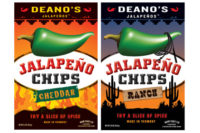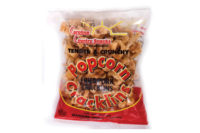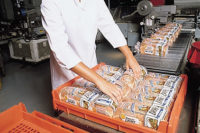Several short-term studies show that controlling portion sizes helps limit calorie intake, particularly when eating high-calorie foods. This is good news for the increasing amount of consumers looking to portion-controlled snacks as a way to eat healthier. It also gives snack manufacturers options for line expansions and additional sales opportunities.
“The portion-control category started quite a few years ago, with the 100-calorie packs,” says Mark Singleton, vice president of sales and marketing at Rudolph Foods Co., Lima, Ohio. “There have been many products introduced at that level to help folks with portion control.”
Because today’s consumers know what they want and speak with their wallets, he emphasizes that “snack manufacturers have to listen to consumers who have a clear understanding of what they’re looking for.”
To better gauge portion-controlled products, Rudolph Foods conducts a number of focus groups annually to determine what consumers are looking for and what snack aspects are important to them. “The best part is right after we’ve finished the written portion of the study,” Singleton says. “When we’re getting into a dialogue [with participants], it’s the most important education we have.”
What has been evident from Rudolph Foods’ perspective is the resilience of portion-controlled snacks, which have remained popular despite the economic downturn and the fact that these items aren’t always visible on store shelves.
“Finding the right place for these snacks can be a challenge at the retail level, since many items don’t fit on a gondola easily,” Singleton notes. “Also, portion-controlled product presentation on the shelf is different than with traditional snacks, since they’re sold in multiples versus eaches.”
As a result, effective merchandising at the store level is sometimes difficult, since bags and pouches don’t fit as well on the shelves as do cartons and boxes.
Education matters
When it comes to healthier snacking, many believe promoting portion-controlled snacks may be a step in the right direction. For some manufacturers of these products, there are no packaging or production issues, but rather more of a learning curve in terms of educating consumers.
“The U.S. has a structural obesity problem, and the food industry has contributed to that,” says Lisa Sherman, brand manager at Walkers Shortbread Inc. “We have a responsibility to provide solutions.” The Hauppauge, N.Y.-based company is known for its shortbread, several varieties of which it offers in 100-calorie, two-cookie packs.
“The 100-calorie range snacks are a growing segment,” says Shane Emmett, CEO of Health Warrior Inc., Richmond, Va., manufacturer of Chia Seeds and Bars. Health Warrior was created, in part, in response to athletes and consumers focused on healthier lifestyles. “The biggest challenge for us is explaining to folks that it’s not the calories in portion-controlled snacks that matter, it’s the amount of nutrition in those calories that’s the issue. People are waking up to that.”
Less than a year ago, Health Warrior launched 110- and 100-calorie Chia Bars for athletes and other consumers looking for healthier snack options. “We received a huge amount of reports from folks who don’t eat an entire 300-calorie bar, so the smaller size makes it easier for people to modify their caloric intake,” Emmett says.
Chia seeds are the main ingredient in these products, which come in chocolate peanut butter, acai berry and coconut flavors. Positioned as a nutritious snack option, the bars contain 1 g. of Omega 3 and 3 g. each of dietary fiber, sugar and protein, and are 100% vegan.
“We are shooting for a low number of calories with a high number of nutrients, so 100 calories of our bar go further than the same calories in a cookie or sugar-based snack,” Emmett says. “With our portion-controlled lines, there’s an educational component, so it’s nutrition, not calories, that matters.”
Smaller portions haven’t been a significant adjustment for popcorn manufacturers, which tend to reduce the size of their bags, in addition to offering 100-calorie servings. “A traditional bag of our microwave popcorn has about three servings [versus one in the portion-controlled line],” says Garrett Smith, president of American Pop Corn Co., makers of Jolly Time Pop Corn, Sioux City, Iowa.
The company has coupled its Healthy Pop line with its full-size offerings in ads, positioning the portion-controlled items as an add-on to traditional sizes, rather than an alternative. “The smaller sizes require adjustments to machinery for production, but the basic packaging is the same,” Smith says. “In our case, our flavor formulas are identical.”
Segment trends
Part of what has kept the portion-controlled snack segment thriving is that it has been positively impacted by food trends. In addition to the focus on healthier eating, these products are easily transportable for grab-and-go consumption, a prosperous segment of the snack industry.
Walkers Shortbread developed its portion-controlled offerings in response to consumers seeking convenient grab-and-go packages. “This is a growing category, due to lifestyle changes, package format innovation and manufacturers seeking higher margins from bite-size cookies that cost more per ounce,” Sherman says.
The company recently expanded its snack-size offerings to include 4.4-oz. bags of its Fingers, Rounds and Chocolate Chip Shortbread cookies. Its best-selling portion-controlled item is the Classic Shortbread Fingers, which are available a two-count pack.
Love & Quiches Desserts, Freeport, N.Y., offers cakes in various sizes, cuts, different price points and container types. “We offer a number of portion options for both the foodservice and retail segments, including squares of cake in a safety-lock container for grab-and-go sections,” says Andrew Axelrod, president.
The company began offering portion-controlled desserts at retail after receiving requests from airline passengers who had tried Love & Quiches foodservice products on their flights. “After getting fan mail, we started our own branded grab-and-go brownie line, which includes 3-oz. products sold in convenience stores and foodservice outlets,” Axelrod says.
Love & Quiches Desserts produces various portion cuts geared for different channels, such as a 2-oz. brownie for vending machines and a 1¼-oz. size for airlines. “Today, people tend to want smaller portions of high-quality, decadent products, rather than a lot of empty calories,” Axelrod notes.
And thanks to packaging film innovations, Love & Quiches’ products have a 60-day shelf life. “In terms of safety, there are many options for plastic packaging with portion-controlled snacks,” Axelrod continues. “On the manufacturing side, we utilize sophisticated equipment that’s expensive, but essential to provide uniform products for customers.”
Because people are always on the go nowadays, the need for convenient snacks goes hand in hand with the portion-controlled segment. The demographic for these products tends to be families with two working parents, although moms are the primary purchasers. “People are looking for single meals, so that’s a big trend,” Axelrod says. “We are seeing half cakes sold in supermarkets.”
The markup from the commercial side makes portion-control an attractive option in terms of profits. From a consumer perspective, many consumers appreciate that there is less waste from uneaten food.
Variety packs were the first portion-controlled products on the market that also enabled consumers to reduce waste, and the success of these items has paved the way for many products of today. “In the future, there will be a balance in terms of packaging and waste,” Singleton says. “Portion-controlled packs have been around a while and will be here to stay.”
Nice niche to be in Consumers also are seeking variety with portion-controlled products. The success of Rudolph Foods’ 80-calorie bags of pork rinds has prompted the company to expand its portion-controlled snacks line to include onion rings and cinnamon churros.
“As we continue to conduct focus groups, we’re amazed at how savvy
consumers are in terms of portion control,” Singleton says. “It’s a nice niche to be in.”
Consumers have become more discriminating in terms of ingredients. This has had an impact on the portion-controlled snack segment. In response, Rudolph Foods has simplified its ingredient statements. The company will produce its Gaslamp popcorn brand with a cleaner label that lists pure cane sugar, canola oil and natural sea salt.
“The only portion-control snack products that struggle are those that don’t taste good,” Singleton says. “That is the continuing barrier to entry for a lot of food. People won’t give up great taste.”
Another company strong in the portion-controlled segment is Quaker Oats Co., Chicago, which offers a number of such products in its Fiber One line. The company’s newest products are Fiber One Chewy Bars in Chocolate and Strawberry PB&J flavors. The 100- and 110-calorie bars are low in sugar and free of high-fructose corn syrup.
An important aspect of the portion-controlled segment is that these products help people make choices when it comes to how much food they eat at one time. Most consumers have an unrealistic view of what a serving looks like. The smaller snack sizes help put the amounts into perspective.
“This is not a new phenomenon,” says American Pop Corn’s Smith. “Portion-controlled microwave popcorn has been around for about five years. For us, it has been the fastest-growing portion of our business.”
Jolly Time’s 100-calorie bag of microwave popcorn has been endorsed by Weight Watchers and is a strong seller. The company has recently unveiled a 10 pack of 100-calorie kettle corn bags and offers a four-pack of Healthy Pop in a butter flavor.
“Butter is our best-selling flavor, in addition to our low sodium portion-controlled line,” Smith says. The primary demographic is weight-conscious consumers and moms buying for their children.
Manufacturers predict that there will continue to be innovative packaging and presentation, and the focus will remain on providing a good value.
“Portion control remains a growing portion of our business, and it should grow for the foreseeable future,” Smith says.




